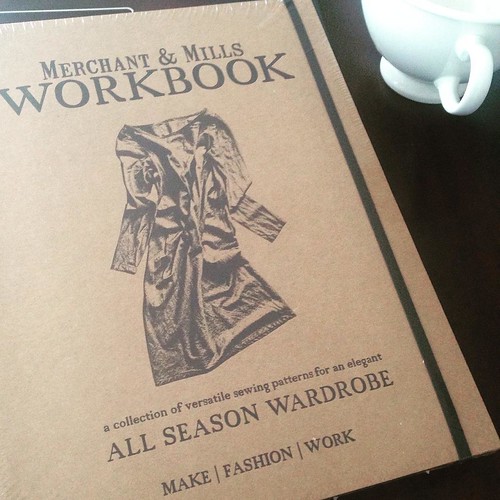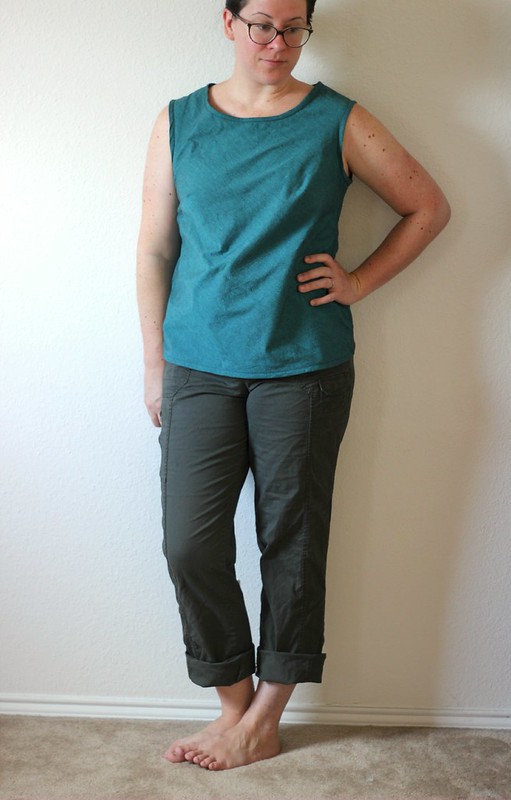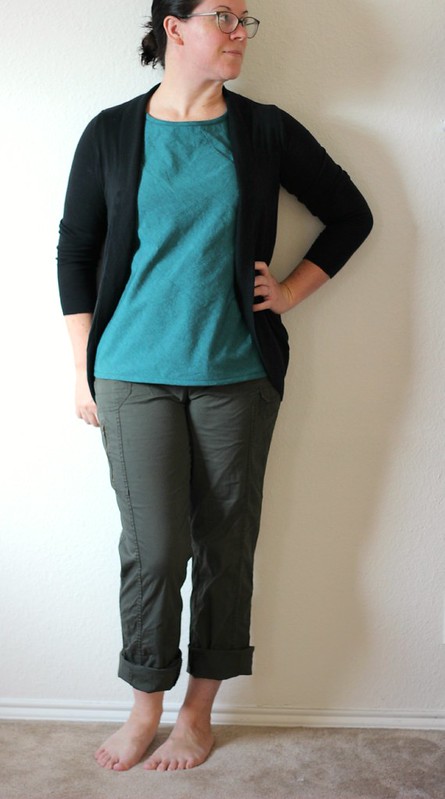This is a book I’ve been looking forward to getting my hands on ever since I first got wind of it being published. I’ve loved all my Merchant and Mills patterns and the only one I’ve held back on making was The Factory Dress– but after seeing this video of Carolyn Denham wearing hers, it has moved up the queue drastically.
I had mentioned in a previous make how nice it would be to have finished garment measurements on the patterns and my dream came true in The Workbook! The sizes show FINISHED measurements so you can know precisely how much ease will be built into your usual size. This came in particularly handy when I was deciding on which size to trace out for the Heron, a bat-wing wrap top.
There are 6 timeless patterns and The Curlew Sleeveless T-shirt is a bias cut top with bust darts for additional shaping. The fabric choice is a crossweave cotton in a lovely teal/emerald with cross threads of black. This has been in the stash for a year, back when I went home to Indiana for a visit with family and went to Margie’s Country Store in Madison, In. It is much thicker and more stiff than what is recommended, but this is a wearable muslin since I wanted to check fit on size 16, which falls on my body measurements the closest.
My guess is that it will be a bit more tricky to sew with a more shifty fabric when I make my next/nicer one in a linen or silk. Since my wearable muslin is more of quilting cotton weight, the bias cut drape isn’t really noticeable. It is incredibly comfy to wear and easy to pull on and off even with the close fit. 
My main problem after finally figuring out how to correctly join the bias tape, was the bust darts. These are to be sewn with a stretch stitch since the bias cut makes it similar to a knit with the give in the fabric. I’d never sewn a bust dart quite like this and it shows, unfortunately. I’m wondering if it’s trickier on bias to sew smooth dart points or if it was a combination of user error/stretch stitch/bias-cut trifecta of terror. Using the ham to try and iron it into a smooth shape didn’t work, either. It will be fixed since I love this top..maybe start a short line of straight stitches near the end of the dart and try to get a smooth tapering? If you’ve sewn with a stretch stitch then you know what a b*tch it is to unpick.
I can see this book one that is used again and again for me, I’m already thinking of making this a short sleeved top. Oh, the possibilities! Thanks, Carolyn, for such an ace sewing book- I’m looking forward to seeing my sewing skills advance with the more involved patterns.




Interesting to read about the bust dart! I hope when you find a fix you will post about it. I have this book (relatively new) but have yet to start anything. I was going to start with either this or the bantam, using some quilting cotton too to make wearable muslin. I would love make them in linen! I like that teal colour on you.
I chose this over the Bantam since it covered more of my shoulders. Thanks, Melissa- I’ll definitely figure out the dart situation and report back when it’s been fixed. It’s most likely user error since I’m still fairly new at sewing.
The Strides pants have me all aflutter, but I know I’m not there yet..there is even some linen that will be perfect in my stash, lol.
So much sense is made now! I typically sew from Japanese Pattern Books, and I could not, for the life of me, make sense of the sizing in the Workbook. I made the size that would normally fit my measurements, but I didn’t add for ease. Now I can identify with the people who make the Japanese patterns without additional seam allowances added, because my garments (also started with a Curlew and Heron) seemed super small. 😦
How did you decide how much ease to add? I have never worked with a pattern that wasn’t designed with ease included. Frustrating.
Kris, most patterns have 3-4 inches of ease built in- so just pick the size that is closest to your bust size + ease..easy peasy 🙂 I sewed a 16, which is my usual size from Merchant and Mills and it fit perfectly. There *is* ease built in, it’s just showing you the FINISHED garment measurement in that size so that you can decide to go up or down a size for more or less ease depending on how you like your clothes to fit. Once you keep that in mind, it should be a lot easier to choose which one to sew. Hope that helps!
Got it! I sewed a 12, but should have gone up to a 14. (There was probably only 1-1.5 inches of difference between my actual bust measurement and the finished garment. Thanks for the quick response!
Lovely article- thank you. I’ve made a few Factory Dresses and worn them a lot. I might have to get the book now! That top is very nice on you.
Thanks, Linda. Of course, I would recommend the book- especially if you already enjoy M&M’s aesthetic!
This is a lovely version! Don’t be so hard on yourself:). I’m surfing the web looking for reviews of the Workbook – and am about to get it once it seems aimed at more advanced sewers than their first two.
Re your darts – if the book instructed you to sew this in a stretch stitch, I would take some of their instructions with a huge pinch of salt. Stretch stitches do not go on wovens. At all. My couture books advise that bias seams should be sewn with a longer stitch – most definitely a straight stitch. No narrow zig zags and definitely no sophisticated stretch stitches. Furthermore, bias is hard enough to press without factoring in uneven stitches. If your stitch for this fabric would normally be around a 2.5, for instance, you would go a little over 3. What you can do with more shifty fabric is cut out the pattern pieces and let them hang overnight over the back of achair, so you get most of the bias give out before you sew
Re finished measurements – maybe it’s because I learnt to sew using Burda, but I have always measured patterns, and still continue to do so even when finished measurements are given. It’s no biggie, try it out. I have found drafting errors in many patterns so I always check measurements and walk the seams. The one time I didn’t I almost ruined some fabulous silk and I swore it would never happen again:).
Thanks, Francesca, hope you enjoy the book! I’ll probably make my next one in some linen I have in abundance with french seams and straight stitch on the bust to see if that fixes things.